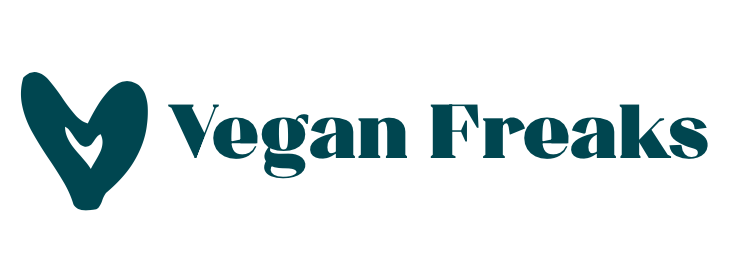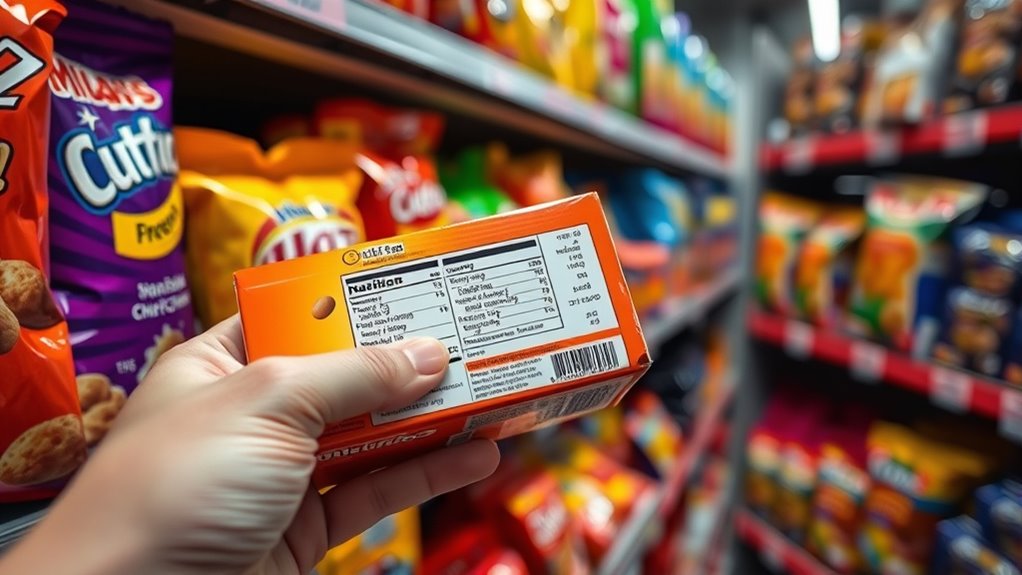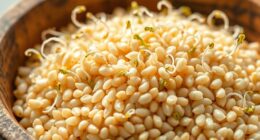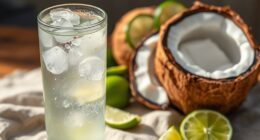To spot sneaky animal-derived additives, check labels carefully for ingredients like gelatin, shellac, and carmine (E120). Watch out for dairy-based items such as casein, whey, and lactose, as well as animal fats like lard. Also, look for egg derivatives, lanolin, honey, and beeswax, which often hide in processed foods. Understanding these hidden sources helps you make ethical and healthy choices. Keep exploring to uncover more tips for identifying animal ingredients.
Key Takeaways
- Learn to identify animal-derived ingredients like gelatin, shellac, isinglass, and carmine on labels to avoid sneaky animal additives.
- Check for hidden dairy components such as whey, lactose, and casein, especially in processed foods.
- Recognize animal fats and substitutes like lard or vegetable oils to make healthier, ethical choices.
- Be aware of egg derivatives like albumin and their plant-based alternatives used as stabilizers and binders.
- Read ingredient lists carefully for processing details and potential cross-contamination of animal-derived substances.
Gelatin
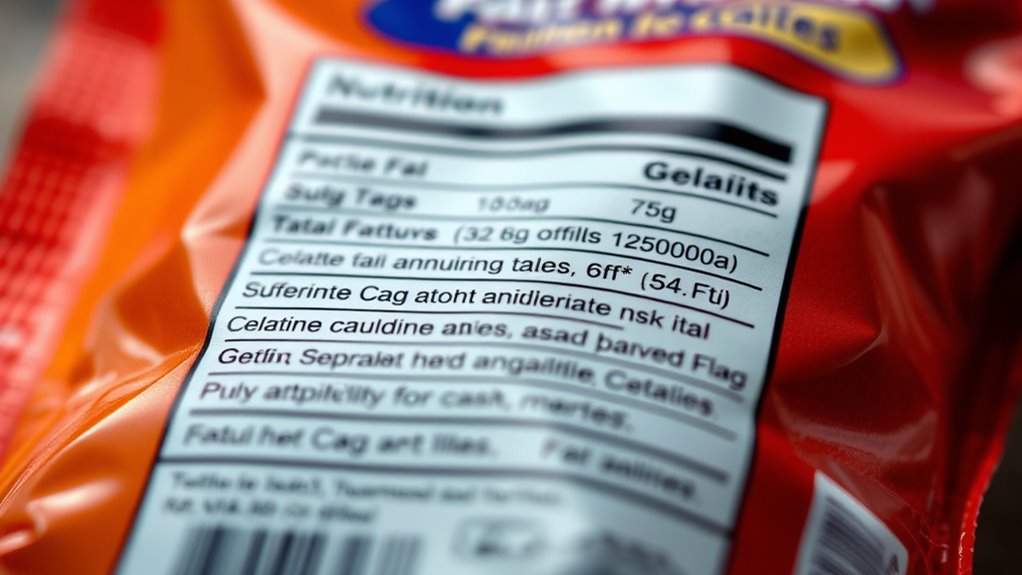
Have you ever wondered what gelatin really is? It’s a protein derived from animal collagen, commonly used as a thickener or gelling agent in foods. If you’re vegetarian or vegan, traditional gelatin isn’t an option, but don’t worry—there are vegetarian gelatin options available. Look for products labeled as vegetarian gelatin or plant-based gelling agents. Vegan alternatives, such as agar-agar, carrageenan, or pectin, work as substitutes and are derived from seaweed or fruits. These options often appear on labels, so it’s essential to read carefully. By understanding how to identify these ingredients, you can make better choices aligned with your dietary preferences and avoid animal-derived additives. Utilizing plant-based gelling agents can help you adhere to a keto diet while avoiding animal products. Additionally, some products may contain additives or stabilizers that are not animal-derived, so always check ingredient lists for hidden animal-derived additives and additive sources. Being aware of food processing techniques can also help you recognize potential hidden animal ingredients in processed foods.
Shellac
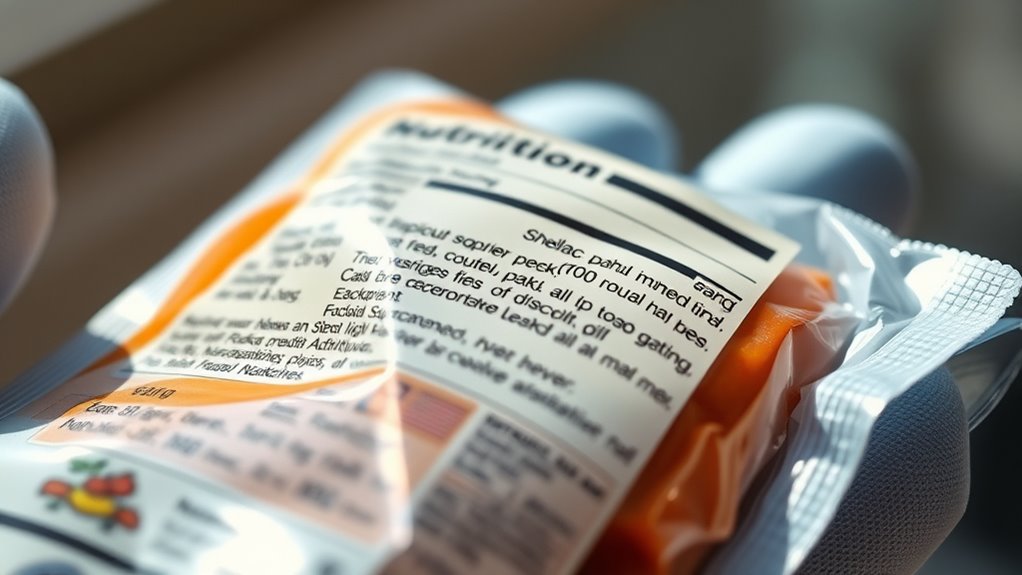
Shellac is a natural resin used as a food coating and finish, often found in candies, pills, and other edible products. It’s derived from secretions of the female lac insect, making it an example of edible insect ingredients. Shellac forms a shiny, protective layer that seals in freshness, but it’s also an animal derived coating. Many consumers are surprised to learn this, especially since it’s widely used in sweets and pharmaceuticals. To help you spot it, here’s a quick reference:
| Food Products | Description |
|---|---|
| Candies | Provides gloss and durability |
| Pills | Acts as a coating for protection |
| Food Coatings | Used for shiny finishes |
Always check labels for shellac if you prefer to avoid animal derived coatings. Recognizing animal-derived ingredients can help consumers make more informed choices, especially as awareness about food additives continues to grow.
Carmine (E120)

Did you know that Carmine, also known as E120, is a vibrant red coloring derived from insects? It’s commonly used in candies, drinks, and baked goods to give a striking hue. If you’re seeking vegetarian alternatives, look for products labeled as suitable for vegetarians, but be aware that many vegan labels explicitly exclude Carmine. Since Carmine comes from crushed beetles, it’s not vegan-friendly, and some vegetarians avoid it too. Checking ingredients lists carefully helps you identify whether a product uses this dye. Many brands now offer plant-based or synthetic colorings to replace Carmine, so you can enjoy colorful treats without animal-derived additives. Being aware of animal‑derived ingredients can help you make more ethical food choices. Additionally, understanding food additive sources can guide you toward more transparent and ethical food selections. Recognizing animal-derived additives in ingredient lists is essential for those adhering to specific diets or ethical standards. Always read labels to guarantee your choices align with your dietary preferences and ethical beliefs. Being knowledgeable about natural sources of food dyes can further assist in making informed choices.
Casein and Sodium Caseinate
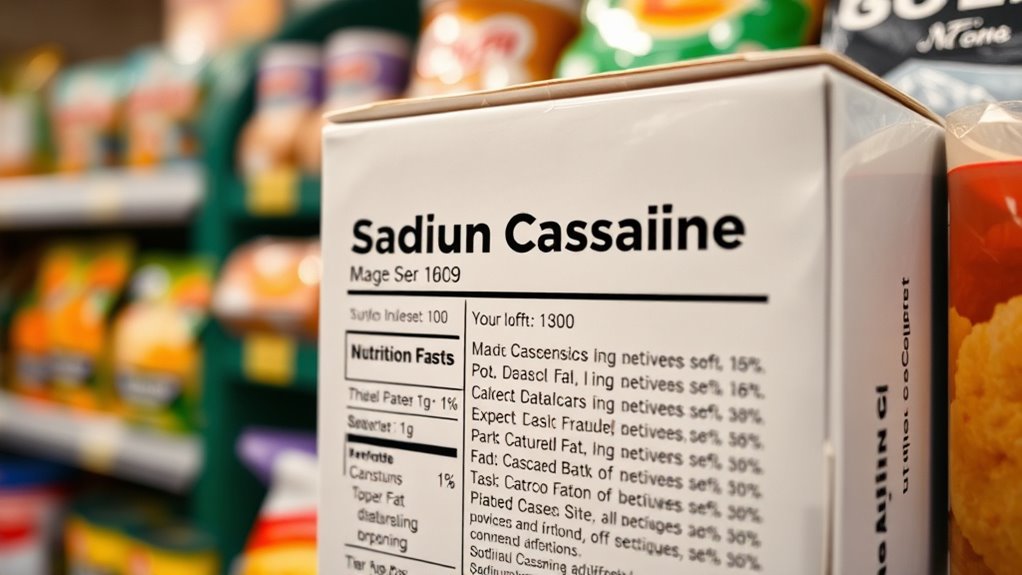
Are you aware that casein and sodium caseinate are popular dairy-derived ingredients used to improve texture and protein content in various food products? These ingredients are forms of animal protein derived from dairy derivatives. When you see them on labels, imagine:
- A creamy, smooth texture that enhances baked goods or processed meats
- A boost in protein, making snacks more satisfying
- A white powder that dissolves easily into liquids, adding richness
Casein and sodium caseinate are often used to stabilize, thicken, or fortify foods. They’re especially favored for their ability to improve mouthfeel and nutritional value, but they’re animal-based, which matters if you’re seeking plant-based options. Always check labels if you want to avoid dairy derivatives or animal proteins. Animal-derived ingredients can be hidden in many processed foods, so reading labels carefully is essential for those with dietary restrictions. Additionally, these ingredients are sometimes used in protein powders and nutritional supplements to enhance their texture and protein content. Understanding food additive functions can help consumers make more informed choices about their diet.
Whey and Lactose
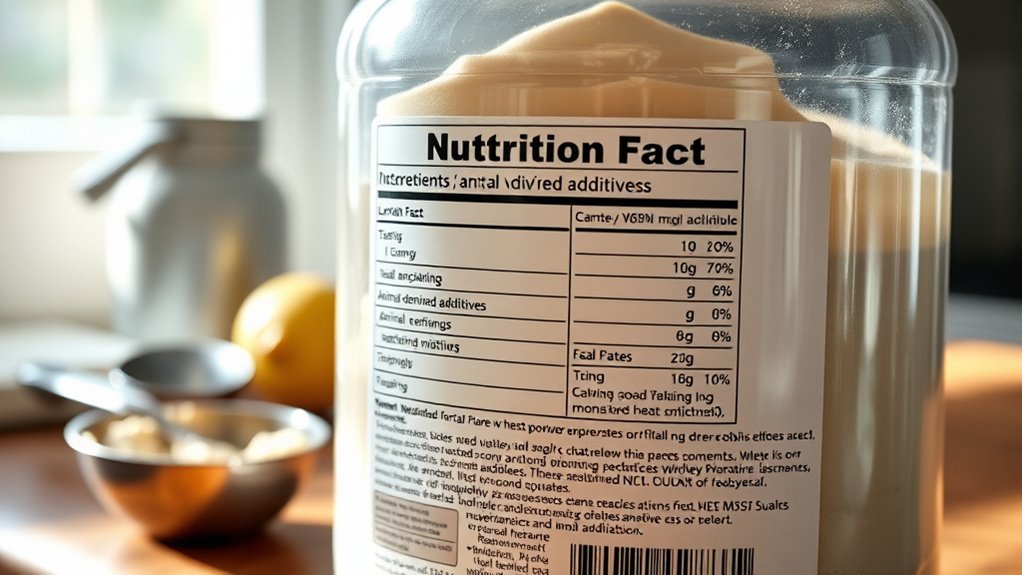
Many dairy-based ingredients, like whey and lactose, can appear hidden on nutrition labels, making it tricky to spot them. You should check for lactose content if you’re lactose intolerant, as it’s often concealed in processed foods. Plus, whey protein is commonly added to boost protein intake, so understanding its presence helps you make informed choices.
Dairy-Based Ingredients
Have you ever wondered what dairy-based ingredients like whey and lactose are doing on your nutrition label? These ingredients can sneak into products through dairy cross contamination during manufacturing. They may appear as:
- A powdered additive in sports drinks or protein bars
- An unexpected ingredient in processed snacks
- Hidden in flavorings or seasoning blends
If you’re lactose intolerant, these ingredients can cause discomfort even in small amounts. Manufacturers might not always list them explicitly, so it is vital to check labels carefully. Dairy cross contamination can introduce whey or lactose into otherwise dairy-free products. Being aware of these traces helps you avoid unwanted reactions. Always consider lactose intolerance considerations, especially if you’re sensitive or have a diagnosed condition, and look for labels indicating dairy-free or lactose-free options.
Hidden Lactose Content
Did you know that foods labeled as dairy-free can still contain hidden lactose or whey? Manufacturers often add whey or other dairy derivatives that aren’t obvious on the label. To avoid surprises, look for alternative terms like “milk serum,” “lactose,” or “whey protein concentrate.” Vegan alternatives are a good choice—they’re free from animal-derived ingredients and clearly labeled. When reading labels, pay attention to ingredient lists and hidden sources of lactose that might be tucked away in processed foods. Remember, “dairy-free” doesn’t always mean lactose-free. Incorporating accurate ingredient identification can help you spot hidden dairy ingredients more effectively. Use label reading tips, such as checking for obscure dairy terms or unfamiliar additives, to make informed choices. Staying vigilant helps you avoid accidental consumption of hidden lactose and supports your dietary preferences.
Whey Protein Uses
Whey protein is commonly used in sports supplements, protein powders, and meal replacements because of its high-quality amino acid profile and rapid absorption. Its versatility makes it popular for muscle recovery and weight management. You might visualize it as:
- A scoop mixing into your shake, creating a smooth, creamy texture.
- Blended with fruits and oats for a quick, nutritious breakfast.
- Added to smoothies for an extra protein boost.
However, if you’re seeking plant-based alternatives, look for vegan protein sources like pea, rice, or hemp proteins, which don’t contain lactose or animal derivatives. These options cater to vegans or those with lactose intolerance, ensuring you get the protein you need without animal-derived additives. Understanding animal-derived additives can help you make informed choices when selecting protein sources.
Isinglass (Fish Bladder)
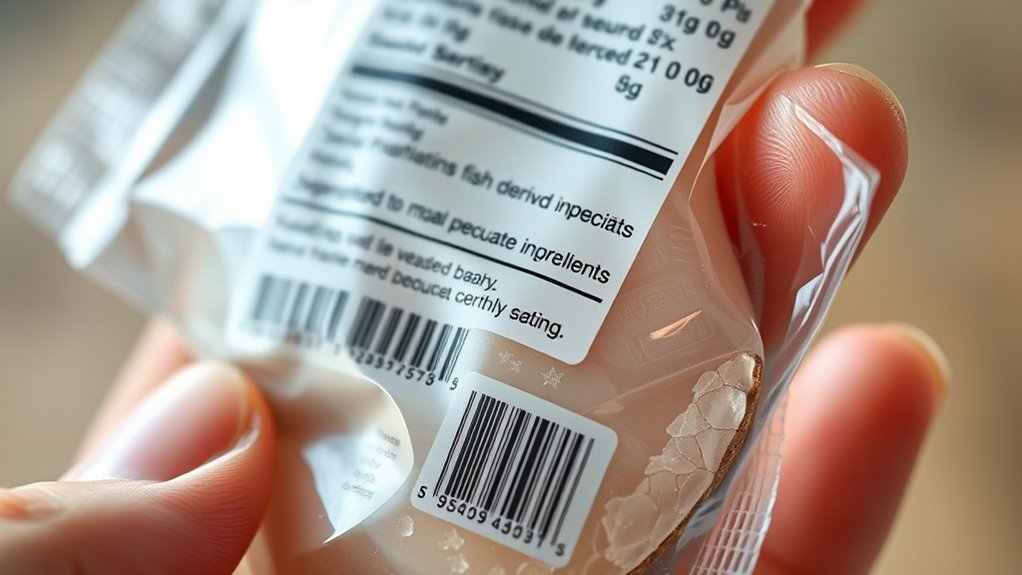
What exactly is isinglass, and why does it appear on nutrition labels? Isinglass is a clear, gelatinous substance made from fish bladder, used to clarify wine and beer. Its presence might surprise you, especially if you’re avoiding animal products. Some manufacturers include it for its filtering properties, but many isinglass alternatives exist. These alternatives, like agar-agar or carrageenan, serve similar functions without animal-derived ingredients. Understanding this helps you make informed choices.
| Isinglass (Fish Bladder) | Alternatives |
|---|---|
| Derived from fish bladder | Plant-based gelatin substitutes |
| Used for clarification | Suitable for vegans |
| Appears on labels as ‘fish collagen’ | Often labeled as ‘vegetarian’ or ‘vegan’ |
| Can be sneaky in labels | Easier to identify and avoid |
Lard and Animal Fats
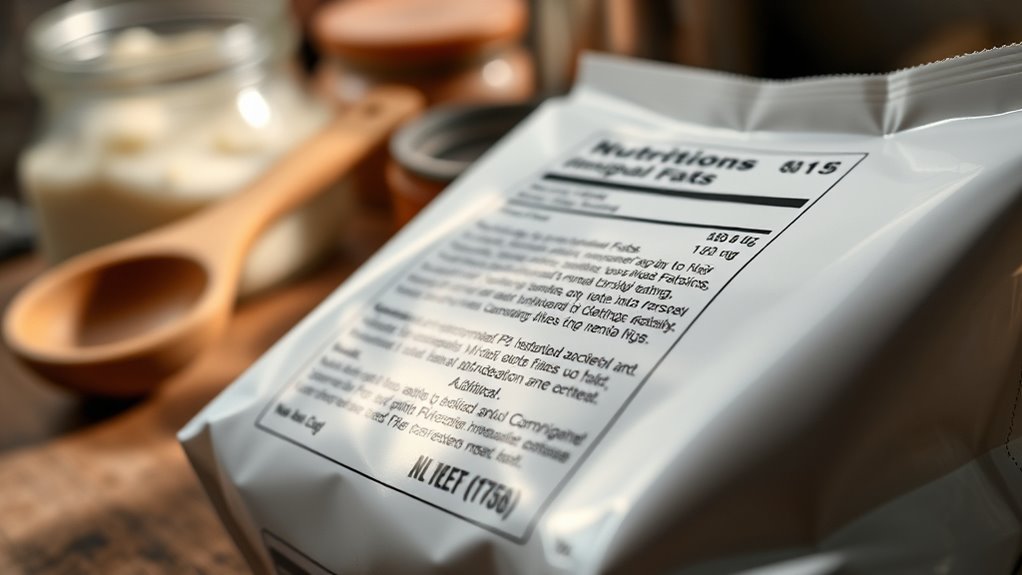
Lard and other animal fats often appear on nutrition labels as sources of saturated fat and calories, which are important for those monitoring their intake. You might see animal fat listed, indicating high saturated fat content that can raise cholesterol. When looking for lard substitutes, consider plant-based options like vegetable shortening or oils. Visualize these options as:
- Creamy, solid blocks of animal fat that melt at room temperature
- Transparent bottles of liquid oils used for frying or baking
- Packaged spreads labeled as “vegetable lard” or “plant-based fats”
Being aware of hidden animal ingredients can help you better identify whether a product contains animal fat or a suitable lard substitute. Recognizing yoga’s holistic approach to physical, mental, and emotional health can also enhance your understanding of mindful eating. Staying aware of these ingredients allows you to make informed choices aligned with your dietary goals.
Honey and Beeswax
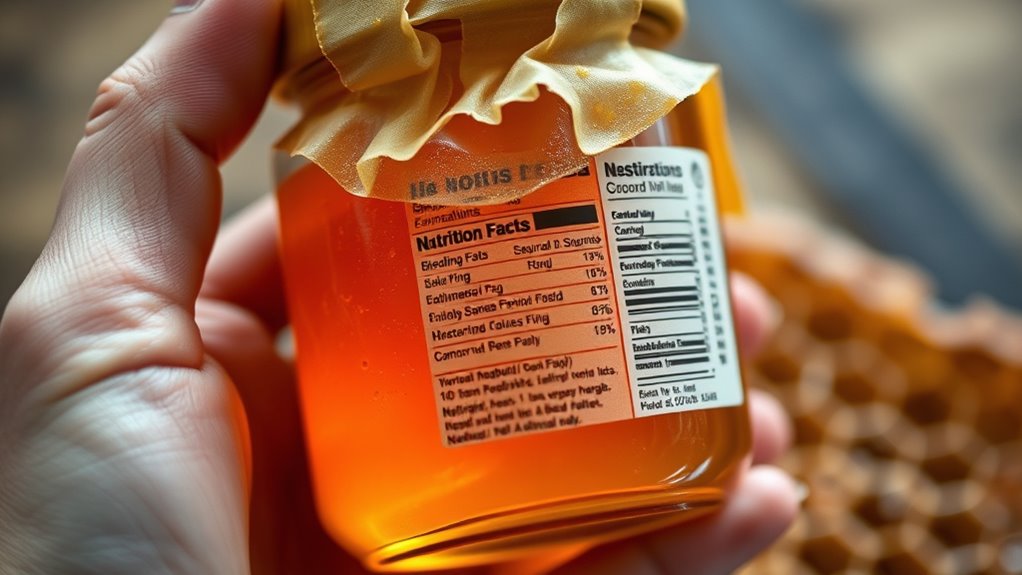
Have you ever wondered how honey and beeswax appear on nutrition labels and ingredient lists? Usually, they’re natural products, but some processed honey may contain additives due to beekeeping practices or honey processing techniques. Beekeepers sometimes use filters or heat to clarify honey, which can alter its purity. Beeswax is often listed simply as “beeswax,” but some products may contain additives or contaminants from hive treatments. To help you identify these, here’s a quick comparison:
| Ingredient | Description |
|---|---|
| Honey | Natural sweetener from bees |
| Beeswax | Wax secreted by bees for hive building |
| Processing | Filtering, heating, or additives |
| Beekeeping practices | Methods affecting purity |
| Additives | Possible contaminants or preservatives |
Knowing these details helps you make informed choices when reading labels.
Albumin and Egg Derivatives

Albumin and egg derivatives come from various sources, including eggs and other animal products. You’ll often find these ingredients listed as additives or stabilizers in processed foods. Keep an eye out for their hidden presence in products you might not expect.
Sources of Albumin
Did you know that egg derivatives are common sources of albumin used in various food products and medical applications? They often come from animal sources like eggs, but plant-based alternatives exist. These alternatives cater to those seeking vegan label claims and avoid animal-derived ingredients. Imagine:
- Plant proteins from soy or peas that mimic albumin’s functions.
- Hydrolyzed plant starches used as stabilizers, replacing egg-based binders.
- Vegan-friendly emulsifiers derived from algae or vegetables for similar consistency.
While animal-derived albumin is traditional, many manufacturers now use plant-based options to appeal to vegans and reduce animal exploitation. Always read labels carefully to identify the true source, especially when supporting plant-based diets or avoiding animal products.
Common Egg Derivatives
Ever wonder what role egg derivatives play in your food and medical products? Egg derivatives like albumin and other egg-based ingredients are often used to improve texture, stability, or binding properties. Their presence depends on egg farming methods, which influence whether they come from conventional or organic sources. These derivatives retain some of the egg’s nutritional value, such as high-quality protein, but are processed to remove fats and yolks. Understanding these common egg derivatives helps you identify hidden animal-derived additives in various products. Manufacturers may include egg derivatives in baked goods, beverages, or supplements to enhance consistency. While they provide functional benefits, they also mean that certain products aren’t suitable for vegans or those with egg allergies. Always check labels if you want to avoid egg-derived ingredients.
Hidden Uses in Products
Have you ever noticed egg derivatives like albumin hidden in products you use daily? These animal-derived ingredients often appear in unexpected places. Imagine these scenarios:
- A creamy salad dressing thickened with egg whites, disguised by a label.
- A bakery item containing egg derivatives, even if it’s labeled vegan.
- A plant-based beverage with added albumin to improve texture, despite vegan certification indicators.
Understanding these hidden uses helps you make informed choices. Some products claim to be plant-based but still include animal derivatives like albumin or egg derivatives. Always check labels carefully, especially if you’re seeking vegan alternatives. Recognizing these sneaky additives empowers you to select truly plant-based alternatives and avoid unintentionally supporting animal exploitation.
Lanolin
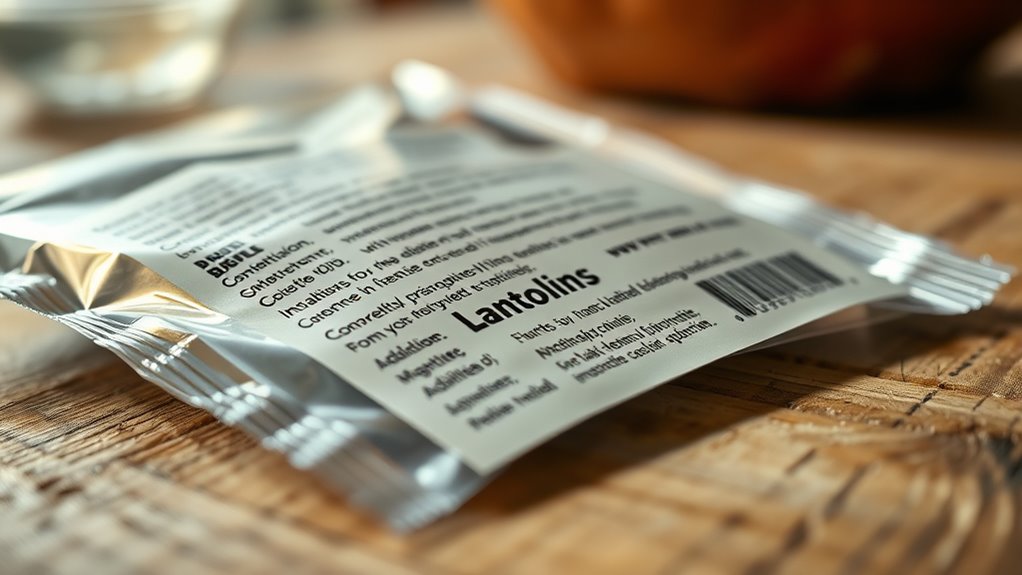
Lanolin is a natural substance derived from sheep’s wool, commonly used in skincare products for its moisturizing properties. It’s fundamentally an animal fat that helps lock in moisture, making it a popular skin moisturizer. When you see lanolin on ingredient labels, know that it’s sourced from sheep’s wool, processed to remove impurities. Many cosmetics and lotions contain lanolin because of its ability to nourish dry or cracked skin. While it’s effective, some people with sensitive skin prefer vegan alternatives. If you’re avoiding animal-derived ingredients, check labels carefully, as lanolin is a sneaky additive hiding behind different names. Understanding that lanolin is derived from animal fat helps you make informed choices about the products you put on your skin.
Frequently Asked Questions
Are There Vegan Alternatives to All Animal-Derived Additives Listed?
You might wonder if vegan alternatives exist for all animal-derived additives. The good news is that many are available, like vegan gelatin made from plant-based sources and plant-based emulsifiers such as lecithin from soy or sunflower. While some additives still lack perfect substitutes, the market is expanding, making it easier to choose plant-based options and avoid animal-derived ingredients altogether.
How Can I Identify Hidden Animal Ingredients in Processed Foods?
Don’t let the cat out of the bag—hidden animal ingredients can lurk in processed foods. You can spot them by carefully reading the ingredient list and looking for suspicious terms like gelatin, casein, or whey. Also, check label symbols or certifications indicating vegan or plant-based products. Knowledge is power; becoming familiar with common animal-derived additives helps you avoid them and make informed choices every time you shop.
Do Organic Labels Guarantee Absence of Animal-Derived Additives?
Organic labels don’t guarantee the absence of animal-derived additives. While organic labeling emphasizes natural ingredients and farming practices, it doesn’t require additive transparency regarding animal-derived substances. You need to check ingredient lists carefully or look for certifications like vegan or plant-based labels if you want to avoid animal-derived additives entirely. Always remember, organic doesn’t automatically mean free from hidden animal ingredients, so scrutinize labels diligently.
Are There Any Health Risks Associated With Consuming Animal-Derived Additives?
Like Pandora’s box, consuming animal-derived additives can pose health risks you might not expect. While many are deemed safe, some could trigger allergies or contain contaminants. Additive safety varies, so it’s wise to stay informed. Always check labels if you’re concerned about health risks, especially if you have allergies or dietary restrictions. Being cautious guarantees you protect your health and avoid unwanted surprises hidden in your food.
Can Cross-Contamination Lead to Unintended Consumption of Animal Products?
Cross contamination issues can definitely lead to accidental ingredient inclusion in your food. If utensils or surfaces aren’t properly cleaned, animal-derived proteins might mix with plant-based foods, risking unintentional consumption. You should be cautious when eating out or preparing food at home, especially if you’re avoiding animal products for ethical or health reasons. Always check for proper handling practices to minimize cross contamination risks and protect yourself from unintentional intake.
Conclusion
Being aware of animal-derived additives helps you make informed choices. Did you know that over 90% of processed foods contain at least one sneaky animal ingredient? By reading labels carefully, you can avoid unwanted animal products and align your diet with your values. Staying vigilant empowers you to enjoy your food without surprises, ensuring transparency and control. Ultimately, knowledge is your best tool for mindful eating and making compassionate, ethical decisions every day.
